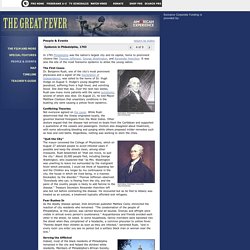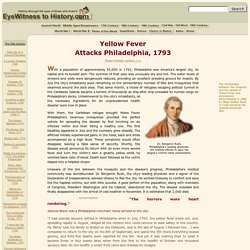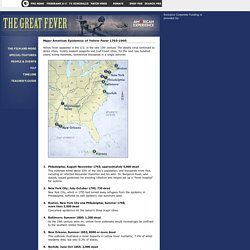

Epidemic in Philadelphia, 1793. People & Events return to index In 1793 Philadelphia was the nation's largest city and its capital, home to prominent citizens like Thomas Jefferson, George Washington, and Alexander Hamilton.

It was also the site of the most fearsome epidemic to strike the young nation. The First Cases Dr. Benjamin Rush, one of the city's most prominent physicians and a signer of the Declaration of Independence, was called to the home of Dr. Conflicting Theories Not everyone agreed on the cause. Yellow Fever — Timelines. Female Aedes aegypti feeding.

Photo credit: James Gathany Yellow fever is a viral hemorrhagic disease spread between humans, as well as between certain other primates and humans, by the bite of yellow fever-infected mosquitoes. The virus is called simply Yellow fever virus and belongs to the virus family Flaviviridae. There are three main types of the disease: Sylvatic yellow fever (also known as “jungle yellow fever”) occurs when the disease is passed from monkeys infected by wild mosquitoes to humans. Intermediate yellow fever—the most common type of outbreak in modern Africa—results when semi-domestic mosquitoes (which can infect both monkeys and humans) are present in an area where they commonly come into contact with humans. Urban yellow fever occurs when the Aedes aegypti species of domestic mosquito transmits the virus between humans, without transmission via other primates.
Yellow fever breaks out in Philadelphia - Oct 11, 1793. Also on this day Lead Story On this day in 2002, former President Jimmy Carter wins the Nobel Peace Prize “for his decades of untiring effort to find peaceful solutions to international conflicts, to advance democracy and human rights, and to promote economic and social development.”

Carter, a peanut farmer from Georgia, served one term as U.S.... American Revolution On this day in 1776, a British fleet under Sir Guy Carleton defeats 15 American gunboats under the command of Brigadier General Benedict Arnold at the Battle of Valcour Island on Lake Champlain, in what is now Clinton County, New York. Automotive On this day in 2008, a man from Belgium named Luc Costermans sets a new world speed record for blind drivers: 192 mph. Civil War Confederate cavalry leader General J.E.B. Cold War Crime Three men blow up the mail car of a Southern Pacific train carrying passengers through southern Oregon in a botched robbery attempt.
General Interest Hollywood Literary Music Old West Presidential. U.S. Army Physicians Discovered the Cause of Yellow Fever. Contagion, The Yellow Fever Epidemic in Philadelphia, 1793. Yellow fever is known for bringing on a characteristic yellow tinge to the eyes and skin, and for the terrible “black vomit” caused by bleeding into the stomach.

Known today to be spread by infected mosquitoes, yellow fever was long believed to be a miasmatic disease originating in rotting vegetable matter and other putrefying filth, and most believed the fever to be contagious. The first major American yellow fever epidemic hit Philadelphia in July 1793 and peaked during the first weeks of October.
Philadelphia, then the nation’s capital, was the most cosmopolitan city in the United States. Two thousand free blacks lived there, as well as many recent white French-speaking arrivals from the colony of Santo Domingo, who were fleeing from a slave rebellion. Major Revolutionary political figures lived there, and in the first week of September, Thomas Jefferson wrote to James Madison that everyone who could escape the city was doing so. Benjamin Rush: Coffee and Blood Web Pages Publications. Yellow Fever. Yellow Fever Attacks Philadelphia, 1793. Yellow Fever Attacks Philadelphia, 1793 With a population of approximately 55,000 in 1793, Philadelphia was America's largest city, its capital and its busiest port.

The summer of that year was unusually dry and hot. The water levels of streams and wells were dangerously reduced, providing an excellent breeding ground for insects. By July the city's inhabitants were remarking on the extraordinary number of flies and mosquitoes that swarmed around the dock area. With them, the Caribbean refuges brought Yellow Fever. Unaware of the link between the mosquito and the disease's progress, Philadelphia's medical community was dumbfounded.
Samuel Breck was a Philadelphia merchant newly arrived to the city: American Experience. Major American Epidemics of Yellow Fever 1793-1905 Yellow fever appeared in the U.S. in the late 17th century.

The deadly virus continued to strike cities, mostly eastern seaports and Gulf Coast cities, for the next two hundred years, killing hundreds, sometimes thousands in a single summer. Philadelphia; August-November 1793; approximately 5,000 dead This outbreak killed about 10% of the city's population, and thousands more fled, including an infected Alexander Hamilton and his wife. Dr. Benjamin Rush, who stayed, issued guidelines for avoiding infection and helped set up a "fever hospital" for victims.